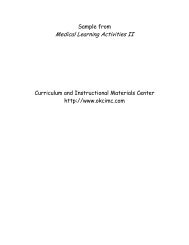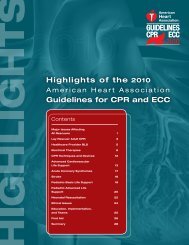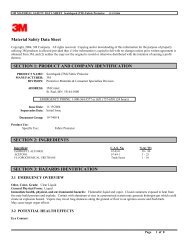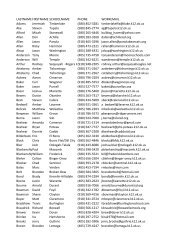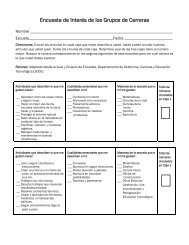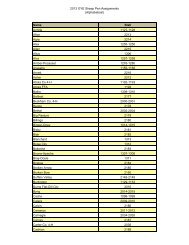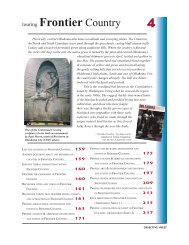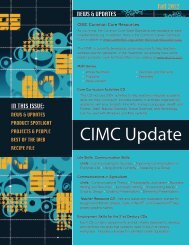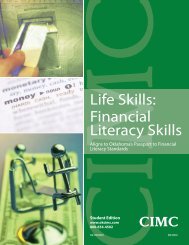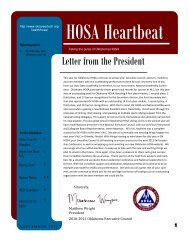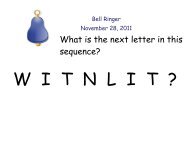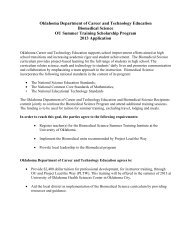Animal Nutrition and Digestion (PDF file, 5.95 MB)
Animal Nutrition and Digestion (PDF file, 5.95 MB)
Animal Nutrition and Digestion (PDF file, 5.95 MB)
You also want an ePaper? Increase the reach of your titles
YUMPU automatically turns print PDFs into web optimized ePapers that Google loves.
Agriscience Principles <strong>and</strong> Applications<br />
s<br />
<strong>Animal</strong> Digestive<br />
Systems<br />
The digestive systems of animals are divided into<br />
two main categories: ruminants <strong>and</strong> monogastrics.<br />
The digestive process of ruminants <strong>and</strong><br />
monogastrics differs. Ruminants are animals that<br />
have stomachs with more than one compartment.<br />
The main components of the digestive system of<br />
ruminants are the rumen, reticulum, omasum, <strong>and</strong><br />
abomasum. The large compartment is the rumen.<br />
Because the rumen can store large quantities<br />
of roughages, ruminants have a greater ability<br />
to process <strong>and</strong> utilize large quantities of bulky<br />
roughages. Examples of ruminants are cattle,<br />
sheep, <strong>and</strong> goats.<br />
Monogastrics, also known as nonruminants,<br />
are animals with relatively small, simple, onecompartment<br />
stomachs containing limited<br />
mircroorganisms. Nonruminants are better adapted<br />
to processing <strong>and</strong> utilizing concentrated feeds<br />
such as grains. Examples of monogastrics are pigs,<br />
chickens, turkeys <strong>and</strong> horses.<br />
Monogastrics<br />
The digestive system of monogastrics can be<br />
divided into several subdivisions. Some have a<br />
functional cecum which increases the animal’s<br />
ability to digest roughage in feeds. Examples of<br />
monogastrics with a functional cecum include<br />
horses, rabbits, guinea pigs, <strong>and</strong> hamsters. Others<br />
have a nonfunctional cecum in which the cecum<br />
is relatively small <strong>and</strong> has little function, limiting<br />
the animal’s ability to digest roughage in feeds.<br />
Examples of nonruminants with a nonfunctional<br />
cecum include pigs, dogs, <strong>and</strong> humans. Another<br />
subdivision of nonruminants is the avian digestive<br />
system. Avians have a digestive system where<br />
special organs (crop, gizzard) soften, crush, <strong>and</strong><br />
grind feed. Examples of avians include chickens<br />
<strong>and</strong> turkeys (poultry).<br />
Ruminants<br />
The first step in the digestive process occurs when<br />
feed is taken into the mouth <strong>and</strong> chewed just<br />
enough to make swallowing possible. The feed<br />
then moves down the esophagus to the rumen,<br />
where it is acted on by millions of microorganisms.<br />
A portion of this feed, in the form of a bolus (cud),<br />
is forced from the rumen back into the mouth<br />
where it is rechewed <strong>and</strong> reswallowed.<br />
The feed then returns to the rumen <strong>and</strong> reticulum<br />
for further storage <strong>and</strong> action by microorganisms.<br />
The feed then moves to the omasum, where water<br />
is squeezed from the food <strong>and</strong> then on to the<br />
abomasum (true stomach) where it is mixed with<br />
digestive juices. From the absomasum, feed moves<br />
to the small intestine where the digestible portion<br />
of the feed is absorbed. The undigestible portion<br />
of the feed moves on to the large intestine <strong>and</strong> is<br />
formed into feces. The feces is stored in the rectum<br />
<strong>and</strong> expelled through the anus.<br />
13<br />
Chewing is the first step in digestion.<br />
Jupiter Images<br />
The digestive process for monogastrics with both<br />
a functional <strong>and</strong> nonfunctional cecum begins<br />
when feed is taken into the mouth, chewed, <strong>and</strong><br />
mixed with saliva. The feed then moves down the<br />
esophagus to the stomach where it is churned <strong>and</strong><br />
mixed with digestive juices. The feed then moves<br />
into the small intestine where most of the digestible<br />
portion is absorbed. After the small intestine, feed<br />
moves to the cecum. In animals with a functional<br />
cecum, additional digestion <strong>and</strong> absorption takes<br />
place. In animals with a nonfunctional cecum, feed<br />
moves on through the digestive system. After feed<br />
moves through the cecum, the undigested portion



